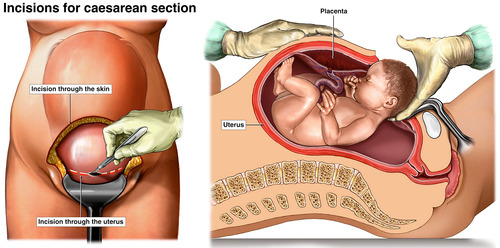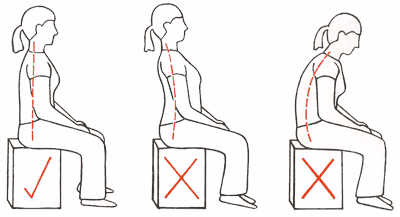
The only thing trickier than adjusting to new motherhood is adjusting to new motherhood AND recovering from surgery at the same time.
So when your doctor gives you the “all clear” six weeks after your c-section, it’s understandable that you might be hoping you can get back to your pre-baby ways.
Not so fast, mama.
Whether your c-section was planned all along or came as a last-minute labour surprise, your body has been through trauma. Even if the surgery went off without a hitch and your doctor is pleased with your healing, your body has been through trauma.
When your doctor signs off on your c-section recovery at your 6-week appointment, it’s not a green light to head back to Crossfit or start training for that half-marathon. It’s the most basic clearance for movement. Like pick up your kid, walk to the store, do your own housework sort of movement.
Safe strength training, like the exercises in this video, will help you be able to do cool things like pick up your kid, walk to the store and do your own housework. OK, there is nothing cool about housework.
Choose movements that feel do-able. Movement in the early postpartum period, and especially after a c-section, should feel nourishing and even a little “too easy.” Movement that is centred around competition, a training schedule, or a fat loss goal will be more likely to cause injury until you’ve healed and rebuilt your strength and confidence. Take your time with healing and you’ll only have to do it once.
Are my abs broken?
Even after the 6-week check up, your tummy might feel numb. Some women even report pain, redness and swelling for several weeks, or months, longer.
The good news is, your abdominal muscles themselves are usually never cut. The cesarean incision goes through your skin and fatty tissues, then through the uterus. Miraculously, your abdominal muscles can actually be separated & pushed aside to make room for the baby, rather than cut.

Still, you’ve had a major surgery. Then you’ve been sewn up and shipped out of the hospital with very little information to help you recover. You might be feeling shocked, angry, ashamed or confused, and you’re not alone in feeling this way. Where is the post-cesarean support? How can you take control of your healing?

Begin with gentle self-massage of the cesarean scar when you feel ready. Mobilizing the tissues around the scar will help to break up “sticky” tissue adhesions that pull your body into poor alignment and can cause pain, as well as help to improve circulation, constipation and bloating. Here’s a c-section massage video you can follow along with! The sooner you can start, the better; however, never massage the site until it’s fully healed.
The average mama spends hours and hours and hours each day sitting and nursing, cuddling, holding, feeding, rocking and generally trying to keep the baby alive. All this sitting can tighten the tissues in the front of the body, particularly if you are hunched over and maybe even – *gasp* – scrolling Facebook while you sit through another marathon breastfeeding session.
Try when you can to be mindful of your seated posture and use pillows to bring baby up to the breast rather than dropping your tired boob down to her. Well, you’re tired, not the boob. You know what we mean.

Safe, gentle movement can help to restore alignment and get those abdominal tissues functioning and healed. Find time in your days for standing more, leisurely walking, light housework (think folding laundry and sweeping floors, not retiling your guest bath) and bodyweight exercise and stretching.
But my pelvic floor is fine, right?
We commonly hear from mamas, “I had a c-section so I should be fine down there.”
Cesarean delivery might mean you didn’t do vaginal labour, though many mamas go through at least a portion of labour, even as far as transition and pushing, then end up with a c-section. No matter how that kid came out, you were pregnant. Your pelvic floor was influenced by the extra weight & pressure of pregnancy, as well as the hormones which relax and soften your tissues, preparing you to give birth and also forcing you to pee yourself when you laugh at that Amy Schumer special.
Many of us have movement and posture patterns that create strain on the core and pelvic floor even before we become pregnant. In fact, many child-free women and even men experience pelvic floor dysfunction.
We recommend all mamas, regardless of delivery method, see a Pelvic Health Physiotherapist for a personal assessment. Many women have pelvic floor dysfunction and don’t have symptoms, or don’t know they’re having symptoms related to the pelvic floor. Better safe than peeing yourself in your sixties, right?
Start with your breath.
Each day, while you rest and read, lie on the couch and catch up on Netflix, or even while nursing in a sidelying position, find 5-10 minutes to connect to your breath. Place your hand or hands on your lower ribs. Inhale deeply through your nose, feeling your ribcage expand into your hand as you fill up with air. You should also feel your pelvic floor/perineum and belly gently softening and rounding. Exhale through your mouth, through pursed lips or by making a “ts” sound which many women find helpful in activating their pelvic floor muscles. You should feel a gentle lift of your pelvic floor/perineum and the sensation of your ribs and belly gently sinking inward. It’s a subtle movement; don’t squeeze your butt, move your hips or brace your abs. This core work is ALL inside.
Aim for a deep inhale of 1-2 counts and a long, slow exhale of 4 counts. These deep, diaphragmatic breaths will open up tight tissues and build the foundation of your core training as well as bring more healing oxygen in with each breath.
Then add movement.
When you feel ready, make those diaphragmatic breaths a part of your exercise routine, along with these 5 full-body exercises in the video below. Do your exercises at a pace which allows you to get an inhale and exhale with a gentle pelvic floor lift on each rep.
Try each of these moves for 1 minute, with 30 seconds rest between. Repeat for a total of 2-3 rounds. Your goal is not to push yourself to exhaustion within that minute, but to do only as much as you can do with good form and proper breathing. If you can’t do the whole minute, rest and join back in. When the minute is up, move on to the next exercise. Gradually, you’ll find the exercises get easier and you naturally move more quickly.
Finish with this pelvic floor & core routine to cool down, and some stretching. This workout is safe to do daily and makes the perfect complement to your walking routine.
SAFE EXERCISES AFTER A C-SECTION
Belly Bootcamp is proud to produce a series of exercise videos in partnership with Canada’s foremost magazine for parents, Today’s Parent. Watch for more videos in this series!
